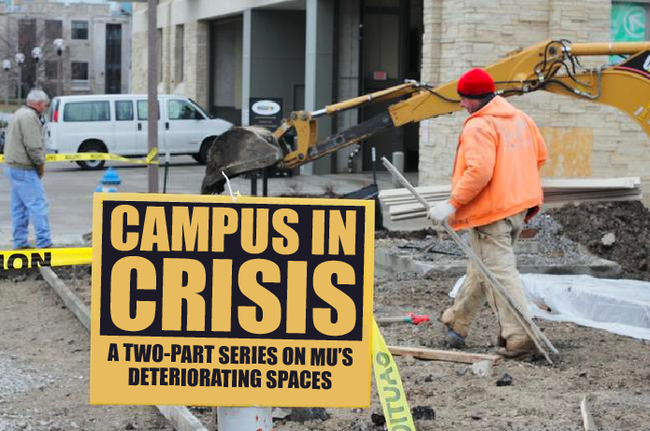
Campus Facilities estimates its total costs for deferred renovation and maintenance on campus could reach $1 billion in 10 years. And, much like a myriad of other public universities across the country, the UM System is burdened with a financial situation that limits the university’s options in taking on these backlogged projects.
The UM System has submitted an Appropriations Request for Operations for fiscal year 2012, but the state legislature will not address those issues until near the end of session.
Mark Schwartz, chief of staff for House Budget Committee Chairman Ryan Silvey, said budgetary planning pertaining to higher education appropriations for deferred maintenance should reach the floor in April.
“There aren’t very many options available to the schools when they have needs like that,” said Paul Wagner, deputy commissioner of the Missouri Department of Higher Education. “University of Missouri, for example, has done some bonding to address some maintenance needs, but you can’t really address them all through bonding.”
Wagner said they are not likely to change either.
“The state’s financial picture is such that it’s really hard to imagine that the state’s going to have a lot of money soon to address deferred maintenance,” he said.
Campus Facilities spokeswoman Karlan Seville said without enough state funding, they are working with what they have.
“I guess at the moment, faculty are making the best of what they have,” she said. “We could definitely improve the learning environment to bring it up to today’s standards.”
MU has a list of buildings that need renovations and construction but has no specific order because what buildings are renovated depends on when money is received and what course of action would best comply with the university’s academic mission, Seville said.
Seville said Lafferre Hall, the Fine Arts Building and Strickland Hall — all of which were classified as three of MU’s most problematic campus buildings in an MDHE 2009 report — are on the list of MU’s buildings in need of renovation, but the university doesn’t have funding for those projects.
“We’ve received some funding from the state, but we’ve received less in recent years,” she said.
The renovations for Tate and Switzler Halls on MU’s campus are being funded by bonds, and many construction projects in the past have been funded by such bonds, including nine Lafferre Hall renovations.
“As state funding for capital projects has substantially declined, it has become necessary for the University (System) to fund more of these projects with their own System Facilities revenue bonds,” said Ann Toellner, UM System director for debt and cash management, in an e-mail.
Toellner said campuses apply for bonds from the UM System on an individual basis, and then the UM System decides which projects are viable. All bonds issued must be approved by the UM Board of Curators, and one bond typically covers multiple projects on a campus. In order for a bond to be issued for a certain project, there must be a viable option in the mix to pay off the bond.
David Sheahen, interim assistant vice president for management services and director of facilities planning and development for the UM System, said during the summer of 2010, the Board of Curators approved $35 million in bond money to go to “critical repair maintenance items” for the four UM System campuses.
“However, that was a one-time response,” he said. “That’s not an option we can use often because we still have to pay the bond off.”
The St. Louis Post-Dispatch reported in a July 2010 article on deferred campus maintenance that it has been about 15 years since the state of Missouri has issued bonds to pay for capital improvements.
Regardless of state funding, campuses are required to invest in their own campus facilities’ needs.
A 1990s mandate stipulated campuses had to invest in facilities at 1.5 percent of the replacement value of all buildings on the campus, Sheahen said.
“It’s a benchmark to reinvest in facilities, to keep them up and keep them in good repair for the programs,” he said.
Since there is a lack of state funding, UM System campuses have not been able to comply with that mandate since 2002, when the mandate was relaxed to 1.25 percent and then down to 1 percent in 2006, Sheahen said.
“We had to also adjust our budgeting,” he said. “We didn’t want to give up on facilities, but we also knew our campuses were strapped for funding.”
Last year, Rep. Chris Kelly, D-Columbia, and Speaker of the House Steven Tilley proposed legislation that would have provided college campuses with more bond money to fund maintenance projects, but the bill never made it to the House floor.
The UM System filed a waiver request to the MDHE on Feb. 7 asking the commissioner to waive the penalty that he could charge for raising tuition above inflation, said Nikki Krawitz, UM System vice president for finance and administration. MDHE signed off on the waiver Monday.
The backlog of deferred maintenance on UM System campuses was one of many factors stipulated in their request justifying an increase in tuition and required fees adopted by the UM Board of Curators, she said.
Until funding comes through to combat the backlog of deferred maintenance, things have been left up to the schools, Wagner said.
“Ultimately it’s up to schools to prioritize the needs with the money that they have, and there are a lot of legitimate needs across campuses, and it’s just part of the challenge of being in a tough economic environment,” Wagner said.